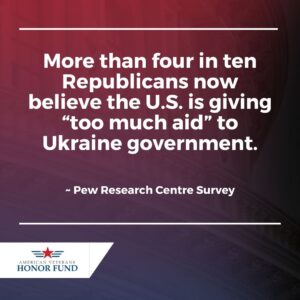In early June 2023, a survey by the Pew Research Centre provided an update on American attitudes towards our role in the Ukraine War. As opinions increasingly divide themselves along partisan lines, results showed that more than four in ten Republicans now believe the U.S. is giving “too much aid” to Zelensky’s government.
However, the US aid to Ukraine survey was not limited to a single demographic. A closer examination of its figures provides deep insights into the factors that currently shape American public opinion.
What the Pew Survey Actually Says on the Ukraine War
For this survey, Pew gathered data from over 5,000 adults between June 5th and June 11th, 2023. The survey included questions about:
- Whether the respondent was following the latest news from Ukraine
- Whether they approved of the President’s response
- Their impression of the amount of aid the US is providing right now
- Their impression of the level of threat represented by Russia
The survey was conducted using an online survey portal, the Center’s American Trends Panel. This tool allowed them to select a representative sample of U.S. residents from around the country. In this way, the survey includes voices from Americans of both genders and a variety of races, ethnicities, and political affiliations.
This aspect is critical because now we can compare how different subgroups within the U.S. feel about Ukraine.
What does each side think about US aid to Ukraine?
The survey found that people of all political affiliations were almost equally likely to be “up to date” with the latest news on Russia’s invasion of Ukraine. However, marked differences appear when asked about their opinion on our involvement in the conflict.
Currently, people who identify with the Republican Party or with conservative politics are remarkably less satisfied with Biden’s actions on the matter, and about the amount of aid we send: 44% of them believe we are giving “too much aid,” the highest number since the early days of the conflict.
Meanwhile, only 14% of those who lean Democrat feel the same way.
This division also persisted when asked about Russia: 38% of Democrats or self-identified liberals stated Russia’s militarism poses a “major threat” to the U.S.; among Republicans, only 28% of respondents agreed.

Where is the curve headed?
This is not the first time Pew has asked the public about their opinions on Russia’s invasion of Ukraine. They performed similar surveys in March 2022, just a month after the initial invasion, and again in January 2023.
Unsurprisingly, opinions have not remained static over the last year and a half. In fact, we can note two main trends:
Overall approval is going down: Past the initial shock, the number of Americans who would prefer the U.S. to send less military aid is steadily increasing. Meanwhile, only a slight majority of people approve of Biden’s response to the Ukraine crisis, which was solid just a year ago. This also matches perceptions of Russia, which now seems less threatening than 18 months ago.
The political gap is widening: In March 2022, 50% of people from all political affiliations considered Russia to be a significant threat, and the difference between Republicans and Democrats was just 1%. Now, there’s a 10% gap between each political camp. Attitudes on the amount of money sent have evolved similarly: in March 2022, 5% of Democrats and 9% of Republicans thought we were sending too much aid. Now, there’s a 30% abyss between each team.
What Does the Current Trend Mean for our Veterans?
It’s impossible to determine how these changing attitudes will affect both veterans and service members.
Currently, sending military aid to Ukraine is a costly enterprise. Under an idealistic lens, spending that money at home – for example, funding V.A. hospitals or providing more scholarships for service members – would be a significant win for military families nationwide.
In addition, our involvement in the Russia-Ukraine conflict is also a powerful diplomatic statement, which could carry much more severe consequences. Our support for Ukraine has soured relations with Russia, increasing geopolitical tensions around the world. But staying out of Ukraine is no guarantee of future peace: it may instead pit us later on against a more powerful, better-supplied Russia.
As a new war now erupts in the Middle East, the most considerable risk may come from our internal divisions. The reasons behind each party’s stance on Ukraine are complex and not immediately apparent – but the fact that opinion is divided along partisan lines in the first place is alarming. Navigating international relations requires walking a fine line between displaying strength and without aggression. To accomplish this, we need to be able to find a common cause within ourselves.
Image Source: Canva


